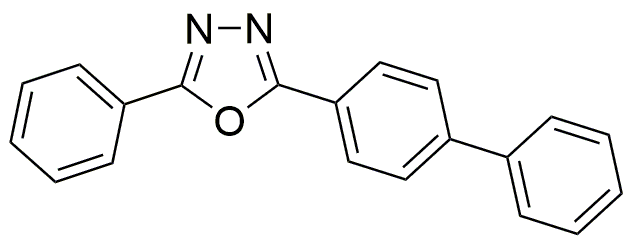2-(4-Biphenylyl)-5-phenyl-1,3,4-oxadiazole is widely utilized in research focused on:
- Organic Electronics: This compound is used in the development of organic light-emitting diodes (OLEDs), enhancing the efficiency and brightness of displays in smartphones and televisions.
- Fluorescent Probes: It serves as a fluorescent probe in biochemical assays, allowing researchers to track cellular processes with high sensitivity and specificity.
- Photovoltaic Cells: The compound is explored in the fabrication of organic solar cells, contributing to the advancement of renewable energy technologies by improving energy conversion efficiency.
- Material Science: It is utilized in creating advanced materials with specific optical properties, which can be applied in coatings and filters for various industrial applications.
- Pharmaceutical Research: Researchers investigate its potential as a drug delivery agent, leveraging its unique chemical structure to enhance the bioavailability of therapeutic compounds.
General Information
Properties
Safety and Regulations
Applications
2-(4-Biphenylyl)-5-phenyl-1,3,4-oxadiazole is widely utilized in research focused on:
- Organic Electronics: This compound is used in the development of organic light-emitting diodes (OLEDs), enhancing the efficiency and brightness of displays in smartphones and televisions.
- Fluorescent Probes: It serves as a fluorescent probe in biochemical assays, allowing researchers to track cellular processes with high sensitivity and specificity.
- Photovoltaic Cells: The compound is explored in the fabrication of organic solar cells, contributing to the advancement of renewable energy technologies by improving energy conversion efficiency.
- Material Science: It is utilized in creating advanced materials with specific optical properties, which can be applied in coatings and filters for various industrial applications.
- Pharmaceutical Research: Researchers investigate its potential as a drug delivery agent, leveraging its unique chemical structure to enhance the bioavailability of therapeutic compounds.
Documents
Safety Data Sheets (SDS)
The SDS provides comprehensive safety information on handling, storage, and disposal of the product.
Product Specification (PS)
The PS provides a comprehensive breakdown of the product’s properties, including chemical composition, physical state, purity, and storage requirements. It also details acceptable quality ranges and the product's intended applications.
Certificates of Analysis (COA)
Search for Certificates of Analysis (COA) by entering the products Lot Number. Lot and Batch Numbers can be found on a product’s label following the words ‘Lot’ or ‘Batch’.
Numéro de catalogue
Numéro de lot/série
Certificates Of Origin (COO)
This COO confirms the country where the product was manufactured, and also details the materials and components used in it and whether it is derived from natural, synthetic, or other specific sources. This certificate may be required for customs, trade, and regulatory compliance.
Numéro de catalogue
Numéro de lot/série
Safety Data Sheets (SDS)
The SDS provides comprehensive safety information on handling, storage, and disposal of the product.
DownloadProduct Specification (PS)
The PS provides a comprehensive breakdown of the product’s properties, including chemical composition, physical state, purity, and storage requirements. It also details acceptable quality ranges and the product's intended applications.
DownloadCertificates of Analysis (COA)
Search for Certificates of Analysis (COA) by entering the products Lot Number. Lot and Batch Numbers can be found on a product’s label following the words ‘Lot’ or ‘Batch’.
Numéro de catalogue
Numéro de lot/série
Certificates Of Origin (COO)
This COO confirms the country where the product was manufactured, and also details the materials and components used in it and whether it is derived from natural, synthetic, or other specific sources. This certificate may be required for customs, trade, and regulatory compliance.

